- Mile run
-
For the tributary stream, see Mile Run (New Jersey).
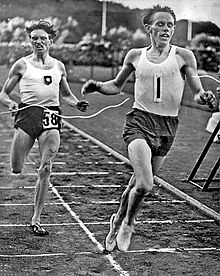 Gunder Hägg (right) defeats Arne Andersson with a world record for the mile of 4:06.2 min in Gothenburg in 1942.
Gunder Hägg (right) defeats Arne Andersson with a world record for the mile of 4:06.2 min in Gothenburg in 1942.
The mile run (1,609.344 metres or 5,280 feet) is a middle-distance foot race which is among the more popular events in track running.
The history of the mile run event began in England, where it was used as a distance for gambling races. It survived track and field's switch to metric distances in the 1900s and retained its popularity, with the chase for the four-minute mile in the 1950s a high point for the race.
In spite of the roughly equivalent 1500 metres race, the mile run is present in all fields of athletics and it remains the only imperial distance for which the IAAF records an official world record. Although the mile does not feature at any major championship competition, the Wanamaker Mile and Dream Mile races are among the foremost annual middle-distance races indoors and outdoors, respectively.
The current mile world record holders are Morocco's Hicham El Guerrouj with 3:43.13 minutes and Svetlana Masterkova of Russia with the women's record of 4:12.56 minutes.
Contents
History
The distance of the English mile gained its current definition of 5,280 feet through a statute of the Parliament of England in 1593.[1] Thus, the history of the mile run began in England and it initially found usage within the wagered running contests of the 18th and 19th century. Such contests would attract large numbers of spectators and gamblers – so many that the activity became a professional one for its more-established participants.[2]
The mile run was at the heart of the divide between professional and amateur sports in the late 19th century. Separate world record categories were kept for amateurs and professionals, with professional runners providing the faster times. High profile contests between Britons William Cummings and Walter George brought much publicity to the sport, as did George's races against the American Lon Myers. The mile run was also one of the foremost events at the amateur AAA Championships.[2] The categories remained distinct but the respective rise in amateurism and decline of the professional sector saw the division become irrelevant in the 20th century.
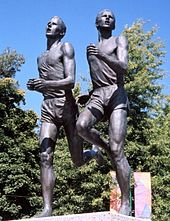 A statue commemorating Roger Bannister and John Landy's Miracle Mile in 1954.
A statue commemorating Roger Bannister and John Landy's Miracle Mile in 1954.
The mile run continued to be a popular distance in spite of the metrification of track and field and athletics in general. It was the 1500 metres – referred to as the metric mile – which was featured on the Olympic athletics programme. The International Amateur Athletics Federation formed in 1912 and ratified the first officially recognised world record in the mile the following year (4:14.4 minutes run by John Paul Jones).[3] The fact that the mile run was the only imperial distance to retain its official world record status after 1970 reflects its continued popularity in the international (and principally metric) era.[4]
The top men's middle distance runners continued to compete in the mile run in the first half of the 1900s – Paavo Nurmi, Jack Lovelock and Sydney Wooderson were all world record holders over the distance.[3] In the 1940s, Swedish runners Gunder Hägg and Arne Andersson pushed times into a new territory, as they set three world records each during their rivalry over the decade.[5] The act of completing a sub-four-minute mile sparked further interest in the distance in the 1950s. Englishman Roger Bannister became the first person to achieve the feat in May 1954 and his effort, conducted with the help of Chris Brasher and Chris Chataway, was a key moment in the rise of the use of pacemakers at the top level of the sport – an aspect which is now commonplace at non-championship middle and long-distance races.[6][7]
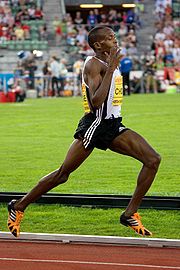 Augustine Choge running the Dream Mile in Oslo in 2008.
Augustine Choge running the Dream Mile in Oslo in 2008.
The 1960s saw American Jim Ryun set world records near the 3:50-minute mark and his achievements popularised interval workout techniques.[5] From this period onwards, African runners began to emerge, breaking the largely white, Western dominance of the distance. Kenya's Kip Keino won the mile at at the 1966 British Empire and Commonwealth Games (which was among the last mile races to be held at a major multi-sport event).[8] Filbert Bayi of Tanzania became Africa's world record holder over the distance in 1975, although New Zealander John Walker broke the record further a few months later to become the first man under 3:50 minutes for the event. The 1980s was highlighted by the rivalry between British runners Sebastian Coe and Steve Ovett, who improved the record five times between them, including two records at the Oslo Dream Mile race. Noureddine Morceli brought the mile record back into African hands in 1993 and Morocco's Hicham El Guerrouj set the current record of 3:43.13 minutes which has stood since 1999.[3]
Mile run contests remain a key feature of many annual track and field meetings, with long-running series such as the Wanamaker Mile at the Millrose Games, Dream Mile at the Bislett Games, and the British Emsley Carr Mile being among the most prominent. Aside from track races, mile races are also occasionally contested in cross country running and mile runs on the road include the Fifth Avenue Mile in New York City
Records
See also: Mile run world record progression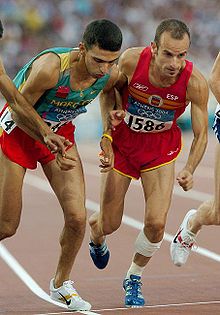 Morocco's Hicham El Guerrouj (left) is the world record holder indoors and out.
Morocco's Hicham El Guerrouj (left) is the world record holder indoors and out.
Outdoor
Area Men's Women's Time Athlete Time Athlete World 3:43.13  Hicham El Guerrouj (MAR)
Hicham El Guerrouj (MAR)4:12.56  Svetlana Masterkova (RUS)
Svetlana Masterkova (RUS)Continental records Africa 3:43.13  Hicham El Guerrouj (MAR)
Hicham El Guerrouj (MAR)4:18.23  Gelete Burka (ETH)
Gelete Burka (ETH)Asia 3:47.97  Daham Najim Bashir (QAT)
Daham Najim Bashir (QAT)4:17.75  Maryam Yusuf Jamal (BHR)
Maryam Yusuf Jamal (BHR)Europe 3:46.32  Steve Cram (GBR)
Steve Cram (GBR)4:12.56  Svetlana Masterkova (RUS)
Svetlana Masterkova (RUS)North, Central America
and Caribbean3:46.91  Alan Webb (USA)
Alan Webb (USA)4:16.71  Mary Slaney (USA)
Mary Slaney (USA)Oceania 3:48.98  Craig Mottram (AUS)
Craig Mottram (AUS)4:22.66  Lisa Corrigan (AUS)
Lisa Corrigan (AUS)South America 3:51.05  Hudson de Souza (BRA)
Hudson de Souza (BRA)4:30.05  Soraya Vieira Telles (BRA)
Soraya Vieira Telles (BRA)Indoor
Area Men's Women's Time Athlete Time Athlete World 3:48.45  Hicham El Guerrouj (MAR)
Hicham El Guerrouj (MAR)4:17.14  Doina Melinte (ROM)
Doina Melinte (ROM)Continental records Africa 3:48.45  Hicham El Guerrouj (MAR)
Hicham El Guerrouj (MAR)4:23.33  Kutre Dulecha (ETH)
Kutre Dulecha (ETH)Asia 3:57.05  Mohamed Suleiman (QAT)
Mohamed Suleiman (QAT)4:24.71  Maryam Yusuf Jamal (BHR)
Maryam Yusuf Jamal (BHR)Europe 3:49.78  Eamonn Coghlan (IRL)
Eamonn Coghlan (IRL)4:17.14  Doina Melinte (ROM)
Doina Melinte (ROM)North, Central America
and Caribbean3:51.34  Bernard Lagat (USA)
Bernard Lagat (USA)4:20.5  Mary Slaney (USA)
Mary Slaney (USA)Oceania 3:52.8  John Walker (NZL)
John Walker (NZL)4:24.14  Kim Smith (NZL)
Kim Smith (NZL)South America 3:56.26  Hudson de Souza (BRA)
Hudson de Souza (BRA)4:42.24  Valentina Medina (VEN)
Valentina Medina (VEN)- Updated 12 June 2011.[9]
All-time top ten
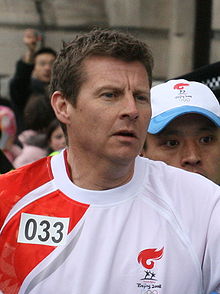 Steve Cram's former world record set in 1985 still makes him the fourth fastest ever.
Steve Cram's former world record set in 1985 still makes him the fourth fastest ever.
Men
Rank Time Athlete Nation Date Location Ref 1 3:43.13 Hicham El Guerrouj  Morocco
Morocco7 June 1999 Golden Gala 2 3:43.40 Noah Ngeny  Kenya
Kenya7 June 1999 Golden Gala 3 3:44.39 Noureddine Morceli  Algeria
Algeria5 September 1993 Rieti Meeting 4 3:46.32 Steve Cram  Great Britain
Great Britain27 July 1985 Bislett Games 5 3:46.38 Daniel Komen  Kenya
Kenya28 August 1998 ISTAF Berlin 6 3:46.70 Vénuste Niyongabo  Burundi
Burundi28 August 1998 ISTAF Berlin 7 3:46.76 Saïd Aouita  Morocco
Morocco2 July 1987 Helsinki 8 3:46.91 Alan Webb  United States
United States21 July 2007 Brasschaat 9 3:47.28 Bernard Lagat  Kenya
Kenya29 June 2001 Golden Gala 10 3:47.33 Sebastian Coe  Great Britain
Great Britain28 August 1981 Memorial van Damme Women
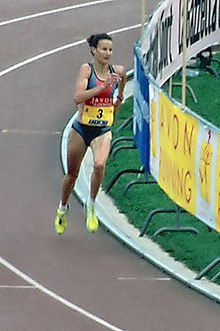 Ireland's Sonia O'Sullivan is the fifth fastest women over the mile.
Ireland's Sonia O'Sullivan is the fifth fastest women over the mile.
Rank Time Athlete Nation Date Location Ref 1 4:12.56 Svetlana Masterkova  Russia
Russia14 August 1996 Weltklasse Zürich 2 4:15.61 Paula Ivan  Romania
Romania10 July 1989 Nice 3 4:15.8 Natalya Artyomova  Soviet Union
Soviet Union5 August 1984 Leningrad 4 4:16.71 Mary Slaney  United States
United States21 August 1985 Weltklasse Zürich 5 4:17.25 Sonia O'Sullivan  Ireland
Ireland22 July 1994 Bislett Games 6 4:17.33 Maricica Puica  Romania
Romania21 August 1985 Weltklasse Zürich 7 4:17.57 Zola Pieterse  Great Britain
Great Britain21 August 1985 Weltklasse Zürich 8 4:17.75 Maryam Yusuf Jamal  Bahrain
Bahrain14 September 2007 Memorial van Damme 9 4:18.13 Doina Melinte  Romania
Romania14 July 1990 Bislett Games 10 4:18.23 Gelete Burka  Ethiopia
Ethiopia7 September 2008 Rieti Meeting - Updated 12 June 2011.[10]
References
- ^ Mile (unit of measurement). Encyclopædia Britannica. Retrieved on 2011-06-12.
- ^ a b Bryant, John (2005). 3:59.4: The Quest to Break the 4 Minute Mile. Random House. ISBN:9780099469087.
- ^ a b c 12th IAAF World Championships In Athletics: IAAF Statistics Handbook (p. 546, 549–50). IAAF. Retrieved on 2011-06-12.
- ^ World Outdoor Records. IAAF. Retrieved on 2011-06-12.
- ^ a b Mile - Introduction. IAAF. Retrieved on 2011-06-12.
- ^ 1954: Bannister breaks four-minute mile. BBC On This Day. Retrieved on 2011-06-12.
- ^ Butcher, Pat (2004-05-04). Completely off pace. The Guardian. Retrieved on 2011-06-12.
- ^ Commonwealth Games Medallists - Men. GBR Athletics. Retrieved on 2011-06-12.
- ^ One Mile Records. IAAF. Retrieved on 2011-06-12.
- ^ One Mile All Time. IAAF (2011-06-10). Retrieved on 2011-06-12.
Events in the sport of athletics Track and field · Road running · Race walking · Cross country running Track Sprints Hurdles 50 m · 55 m · 60 m · 100 m · 110 m · 400 mMiddle distance Long distance Relays 4 × 100 m · 4 × 200 m · 4 × 400 m · 4 × 800 m · 4 × 1500 m · Distance medley relay · Sprint medley relay · Swedish relayField Throws Jumps Combined Road Running Walking 10 km · 20 km · 50 kmMultiday race · Ultramarathon · Wheelchair racing · Backward running Categories:- Events in athletics (track and field)
- Middle distance running
Wikimedia Foundation. 2010.
